The action of an electric field on electric charges
Electrification of bodies
Electrification- the phenomenon of accumulation of electric charge by the body. At least two bodies always participate in electrification. For a phenomenon to occur between bodies, close contact is necessary. Sometimes such contact is achieved due to friction between the bodies, which leads to an erroneous opinion about the need for friction or work to electrify the bodies. The phenomenon of electrization is explained through the movement of free charges (electrons).
There are several ways to electrify.
1. Electrification by friction. In this case, two previously uncharged bodies made of different substances are used. In the process of electrification, the charge is accumulated by both bodies, one is positive, the other is negative and equal in absolute value to the charge of the first body (the law of conservation of charge). From the point of view of molecular-kinetic theory, when electrified by friction, a substance with a stronger interaction captures electrons from the second substance and accumulates a negative charge.
2. Electrification by contact. In this case, several bodies can participate, the substances of which are capable of conducting electric charges. Before contact, one or more bodies had electric charges. After contact, the charges are redistributed in proportion to the electrical capacity of the bodies.
3. Electrification by electrostatic induction (see the section "Conductors in an electric field").
Interaction of charges. Two types of charge
Electric charge– basic scalar physical quantity, which determines the intensity electromagnetic interactions. A body is said to have an electric charge if, in its interaction with other bodies, forces of an electrical or magnetic nature are detected. The unit of electric charge is introduced through the unit of current strength.
[q] = Cl = A∙s.
1 cl- this is the charge passing through the cross section of the conductor at a current strength of 1 A in 1 s.
Consider the properties of the electric charge obtained experimentally.
1. There are two types of electric charges. positive called the charge of a glass rod, received by it when it is electrified by rubbing against silk. A positive charge is a lack of electrons in a body. negative called the charge of an ebonite stick, received by it when electrified by friction against wool (fur). negative charge is an excess of electrons in the body.
2. Charges of the same name repel, opposite charges attract. The interaction forces of point charges are directed along the straight line connecting them. The magnitude of the interaction is described in Coulomb's law.
3. There is a limit to the divisibility of electric charge. Elementary called the minimum (indivisible) electric charge of the body. An elementary particle with a positive elementary charge is a proton, a negative one is an electron. Meaning elementary charge is a fundamental physical constant: e= 1.6∙10 –19 C.
Electric charge is discrete: | q| = Ne.
Electric charge has the property of conservation.
used to detect charges. electroscope.
The law of conservation of electric charge
One of the main properties of an electric charge is its ability to be stored. The law of conservation of electric charge: in an electrically isolated system, the algebraic sum of the electric charges of all bodies included in this system remains constant.
electrically isolated system - a system through the boundary of which there is no charge transfer in any direction.
Coulomb's law
 The law of interaction of electric charges was established experimentally by the French physicist C. Coulomb in the second half of the 18th century. The law is formulated as follows: the module of the interaction force of two fixed point charges is directly proportional to the product of the modules of these charges and inversely proportional to the square of the distance between them.
The law of interaction of electric charges was established experimentally by the French physicist C. Coulomb in the second half of the 18th century. The law is formulated as follows: the module of the interaction force of two fixed point charges is directly proportional to the product of the modules of these charges and inversely proportional to the square of the distance between them.
For vacuum and air, Coulomb's law is written as follows:
where k is the coefficient of proportionality, depending on the choice of the system of units. in SI

where  – electrical constant.
– electrical constant.
For an infinite homogeneous and isotropic dielectric medium, Coulomb's law has the form:
where ε is the permittivity of the medium in which the charges are located.
Coulomb's law is valid for point charges- charged bodies, the dimensions of which are much smaller than other dimensions of the system under consideration. If a charged body under the conditions of this problem cannot be considered a point charge, then it is considered as a set of point charges. The force with which such a body will act on another body is determined according to the principle of superposition of forces.
Action electric field for electric charges
To describe the interaction of electric charges in early XIX century, the English physicist M. Faraday proposed to use the concept of an electric field.
Electric field- a material medium that mediates the action of one charge on another and transmits this action at a finite speed.
Faraday's idea: any electric charge creates a material object in the entire space surrounding it - electric field, which acts on other electric charges with some force called electrical force , and decreases with distance from the charge that creates it.
The charge endows the surrounding space with special physical properties, the main of which is the action with an electric force on any charge placed in this space.
The field created by stationary electric charges does not change with time and is called electrostatic.
Electric fields are usually represented graphically using lines of force- lines, tangents to which at any point coincide with the direction of the tension vector at this point. The graphic representation of electric fields is given in compliance with the following rules:
1) lines of force electric fields start on positive charges and end on negative ones;
2) lines of force do not intersect;
3) the line density is proportional to the magnitude of the intensity vector at a given location in the field.
 The figures show a few examples. graphic image fields.
The figures show a few examples. graphic image fields.
An electrostatic field is stationary (constant) if its strength does not change over time. Stationary electrostatic fields are created by stationary electric charges.
An electrostatic field is homogeneous if its intensity vector is the same at all points of the field; if the intensity vector at different points differs, the field is inhomogeneous. Uniform electrostatic fields are, for example, the electrostatic fields of a uniformly charged end plane and a flat capacitor far from the edges of its plates.
One of the fundamental properties of an electrostatic field is that the work of the forces of an electrostatic field when moving a charge from one point of the field to another does not depend on the trajectory of movement, but is determined only by the position of the initial and final points and the magnitude of the charge. Consequently, the work of the forces of the electrostatic field when moving the charge along any closed trajectory is equal to zero. force fields, which have this property, are called potential or conservative. That is, an electrostatic field is a potential field, the energy characteristic of which is the electrostatic potential associated with the intensity vector E ratio:
E = -gradj.
For a graphical representation of an electrostatic field, lines of force (tension lines) are used - imaginary lines, the tangents to which coincide with the direction of the intensity vector at each point of the field.
For electrostatic fields, the principle of superposition is observed. Each electric charge creates an electric field in space, regardless of the presence of other electric charges. The strength of the resulting field created by the system of charges is equal to the geometric sum of the strength of the fields created at a given point by each of the charges separately.
Any charge in the surrounding space creates an electrostatic field. To detect a field at any point, it is necessary to place a point test charge at the observation point - a charge that does not distort the field under study (does not cause a redistribution of charges that create the field).
Field created by a solitary point charge q, is spherically symmetric. The intensity modulus of a solitary point charge in vacuum using Coulomb's law can be represented as:
E \u003d q / 4pe about r 2.
Where e o is an electrical constant, \u003d 8.85. 10 -12 f/m.
Coulomb's law, established with the help of the torsion balances he created (see Coulomb balances), is one of the basic laws describing the electrostatic field. It establishes a relationship between the force of interaction of charges and the distance between them: the force of interaction of two point motionless charged bodies in a vacuum is directly proportional to the product of the modules of the charges and inversely proportional to the square of the distance between them.
This force is called Coulomb, and the field is called Coulomb. In the Coulomb field, the direction of the vector depends on the sign of the charge Q: if Q > 0, then the vector is directed along the radius from the charge, if Q ? times (? - the dielectric constant of the medium) is less than in vacuum.
experimental established by law Coulomb and the principle of superposition make it possible to completely describe the electrostatic field of a given system of charges in vacuum. However, the properties of the electrostatic field can be expressed in a different, more general form, without resorting to the concept of the Coulomb field of a point charge. An electric field can be characterized by the flux value of the electric field strength vector, which can be calculated according to Gauss's theorem. The Gauss theorem establishes a relationship between the flow of electric field strength through a closed surface and the charge inside this surface. The flux of intensity depends on the distribution of the field over the surface of a particular area and is proportional to the electric charge inside this surface.
If an insulated conductor is placed in an electric field, then on free charges q there will be a force acting on the conductor. As a result, a short-term movement of free charges occurs in the conductor. This process will end when the own electric field of the charges that have arisen on the surface of the conductor completely compensates for the external field, i.e., an equilibrium distribution of charges is established, at which the electrostatic field inside the conductor vanishes: at all points inside the conductor E= 0, that is, the field is absent. The lines of force of the electrostatic field outside the conductor in close proximity to its surface are perpendicular to the surface. If this were not so, then there would be a component of the field strength, a current would flow along the surface of the conductor and over the surface. Charges are located only on the surface of the conductor, while all points on the surface of the conductor have the same potential value. The surface of a conductor is an equipotential surface. If there is a cavity in the conductor, then the electric field in it is also equal to zero; electrostatic protection of electrical devices is based on this.
If a dielectric is placed in an electrostatic field, then a polarization process occurs in it - the process of dipole orientation or the appearance of dipoles oriented along the field under the influence of an electric field. In a homogeneous dielectric, the electrostatic field due to polarization (see. Polarization of dielectrics ) decreases in once.
In SI, the coefficient of proportionality in Coulomb's law is
k \u003d 9 10 9 N m 2 / C 2.
According to Coulomb's law two point charge 1 C each, located in vacuum at a distance of 1 m from each other, interact with the force F= 9·10 9 H, approximately equal to the weight of the Egyptian pyramids. It is clear from this estimate that the pendant is a very large unit of charge. In practice, therefore, submultiple coulomb units are usually used.
The previously considered Coulomb's law establishes the quantitative and qualitative features of the interaction of point electric charges in vacuum. However, this law does not answer the very important question about the mechanism of interaction of charges, i.e. whereby the action of one charge is transferred to another. The search for an answer to this question led the English physicist M. Faraday to the hypothesis of the existence of an electric field, the validity of which was fully confirmed by subsequent studies. According to Faraday's idea, electric charges do not act directly on each other. Each of them creates an electric field in the surrounding space. The field of one charge acts on another charge, and vice versa.
All of the above allows us to give the following definition:
electric field - this is a special type of matter through which the interaction of electric charges is carried out.
Electric field properties
Electric field financially, i.e. exists independently of our knowledge of it.
Generated by electric charge: around any charged body there is an electric field.
The field created by stationary electric charges is called electrostatic .
An electric field can also be created by an alternating magnetic field. Such an electric field is called eddy .
Electric field distributed by in space with final speed equal to the speed of light in vacuum.
The action of an electric field on electric charges
The electric field can be viewed as mathematical model describing the value of the quantity tension electric field at a given point in space.
The electric field is one of the components unified electromagnetic field and manifestation of electromagnetic interaction


Must enter quantitative characteristics of the field. After that, the electric fields can be compared with each other and continue to study their properties.
To study the electric field, we will use test charge: under trial charge we will understand a positive point charge that does not change the electric field under study .
Let the electric field be created by a point charge q 0 . If a test charge q 1 is introduced into this field, then a force will act on it.
note that in this topic we use two charges: the source of the electric field q 0 and the test charge q 1. The electric field acts only on the test charge q 1 and cannot act on its source, i.e. on charge q 0 .
According to Coulomb's law, this force is proportional to the charge q 1:
.
Therefore, the ratio of the force acting on the charge q 1 placed at a given point in the field to this charge at any point in the field:
does not depend on the placed charge q 1 and can be considered as a characteristic of the field. This power characteristic fields are called electric field strength .
Like force, field strength is a vector quantity, it is denoted by the letter .
The field strength is equal to the ratio of the force with which the field acts on a point charge to this charge.
3. Electric field.
3.01. What physical quantity is determined by the ratio of the force with which an electric field acts on an electric charge to the value of this charge?
G.) electrical capacity.
3.02. What is the name of the ratio of work done by an electric field when moving positive charge, to the charge value?
BUT.) potential energy electric field;
B.) electric field strength;
AT.) electrical voltage;
G.) electrical capacity.
3.03. What direction is taken as the direction of the electric field strength vector?
A.) the direction of the force vector acting on a positive point charge;
B.) the direction of the force vector acting on a negative point charge;
B.) the direction of the velocity vector of a positive point charge;
D.) the direction of the velocity vector of a negative point charge.
3.04. Which of the following mathematical notations determines the energy of a charged capacitor?
BUT.) ; B.) 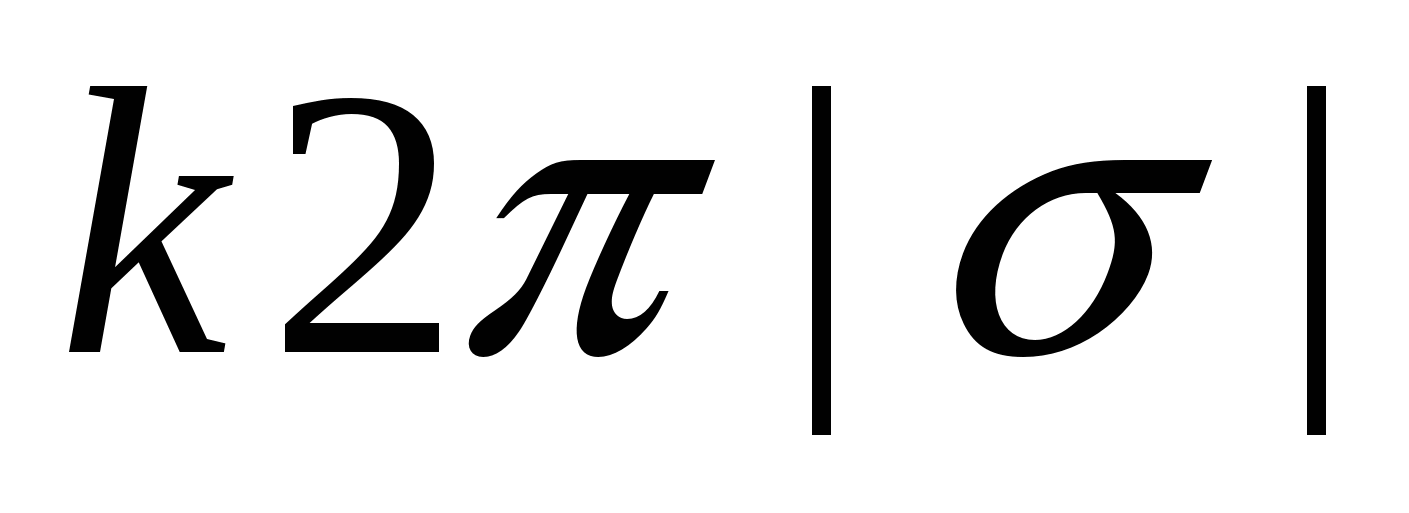 ; AT.)
; AT.)  ; G.)
; G.)  .
.
03.05. Does a positively charged body contain an excess or lack of electrons?
A.) excess of electrons; B.) lack of electrons;
B.) an excess of protons; G.) lack of protons.
3.06. What is the form in SI of the formula of Coulomb's law for vacuum?
BUT.)  ; B.)
; B.) 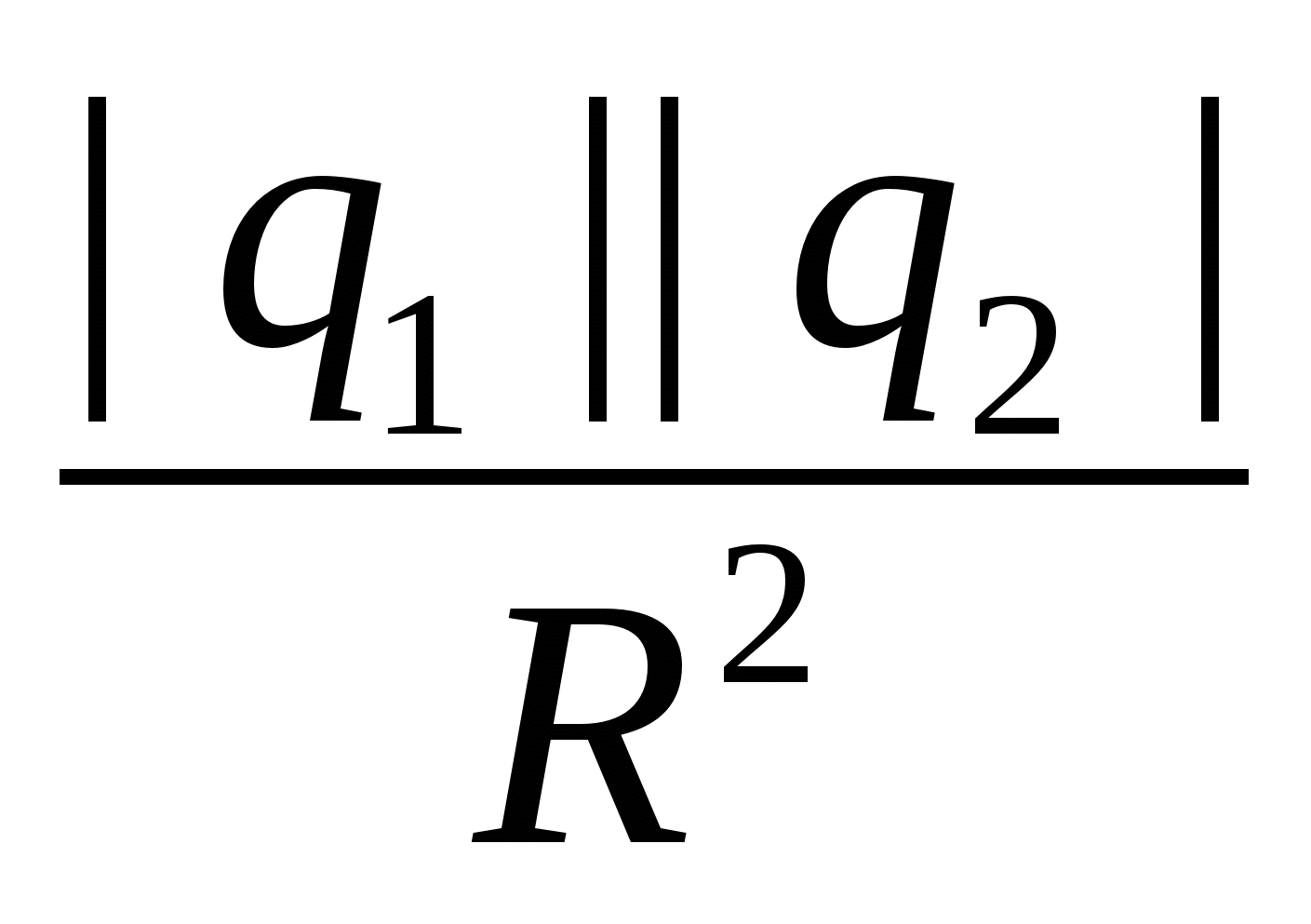 ; AT.)
; AT.)  ; G.)
; G.)  .
.
3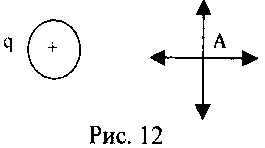 .07. What is the direction of the vector
.07. What is the direction of the vector 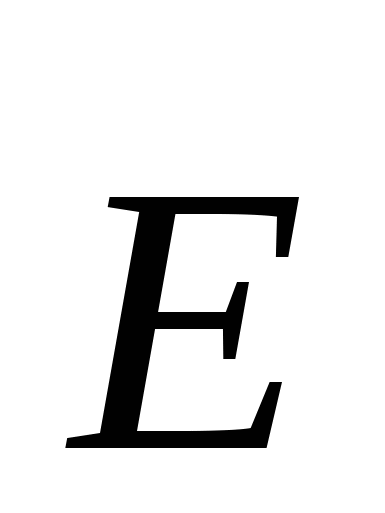 at point A of the field, if the field is created by a positive charge q (see Fig. 12)?
at point A of the field, if the field is created by a positive charge q (see Fig. 12)?
A.) to the right;
B.) to the left;
B.) up;
G.) down.
3.08. Can lines of force intersect?
A.) can; B.) cannot; B.) It depends on the configuration of the field.

3.09. An uncharged metal body (Fig. 13) is introduced into the electric field of a positive charge, and then divided into parts 1 and 2. What electric charges do both parts of the body have?
A.) 1 - negatively charged, 2 - positively;
B.) 1 - positively charged, 2 - negatively;
C.) 1 and 2 are positively charged;
D.) 1 and 2 are negatively charged.
3.10. Does the capacitance of a capacitor depend on the charge on its plates?
A.) yes, in direct proportion;
B.) yes, inversely proportional;
B) is independent.
3.11. How will the electric field strength of a point charge change in absolute value when the distance from the charge to the point under study decreases by 2 times and the charge increases by 2 times?
B.) will increase 8 times; D.) will decrease by 8 times; D) will not change.
3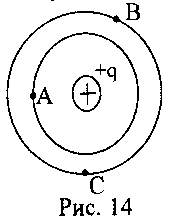 .12. Compare the values of the work of the field created by the charge +q when moving the charge from point A to point B and to point C (Fig. 14).
.12. Compare the values of the work of the field created by the charge +q when moving the charge from point A to point B and to point C (Fig. 14).
A.) A AB > A AC;
B.) A AB C.) A AB \u003d A AC;
D.) A AB \u003d A AC \u003d 0.
3.13. How many times will the capacitance of a flat capacitor change if, without changing the distance, glass is inserted into the space between the plates of the capacitor with  =7 instead of paraffin
=7 instead of paraffin 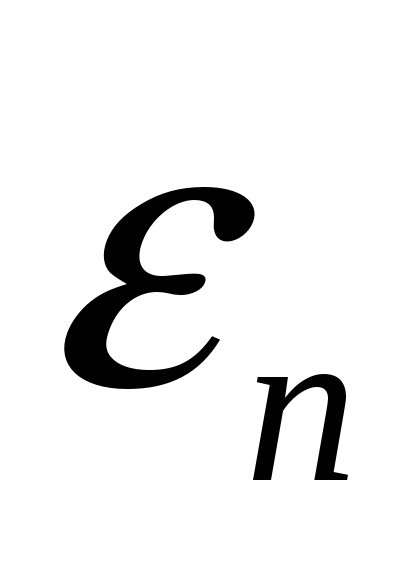 = 2?
= 2?
A.) will increase by 3.5 times; B.) will decrease by 3.5 times; B) will not change.
3.14. The charge on the capacitor was doubled. How many times has the energy of the capacitor changed?
A.) will increase by 2 times; B.) will decrease by 2 times;
B.) will increase by 4 times; G.) will decrease by 4 times; D) will not change.
3.15. When the capacitor was charged with a charge of 5 μC, the energy of the capacitor turned out to be 0.01 J. Determine the voltage on the capacitor plates.
A.) 2 kV; B.) 0.1 ∙ 10 -8 V; B.) 4 kV; D.) 0.2 μV.
3.16. What work is done by the forces of the electrostatic field when moving a charge of 2 nC from a point with a potential of 20 V to a point with a potential of 10 V?
A.) 20 J; B.) 40 J; B.) 2 ∙ 10 -8 J; G.) 2 ∙ 10 -10 J.
3.17. Two point electric charges at a distance R interact with a force of 20 N in a vacuum. How will the interaction force of these charges change at the same distance R in
medium with permittivity ε = 2?
A.) 40 N; B.) 10 N; B.) 5 N; D) will not change.
3.18. The electric field is created by the charge q. At point A, located at a distance of 0.1 m from the charge, the field strength is 1800 V/m. Determine the amount of charge.
A.) 0.5 nC; B.) 2 ∙ 10 9 C; B.) 18 C; D.) 2 nC.
3.19. Two charged bodies of the same name in vacuum interact with a force of 1 N. What will be the force of their interaction if the distance between them is increased by 4 times?
A.) 0.5 N; B.) 0.25 N; B.) 2 N; G.) 4 N.
3.20. A point charge placed in a liquid medium creates a potential of 15 V at a point 0.4 m away from the charge. The charge is 5 nC. What is the dielectric constant of the medium?
A.) 1.8; B) 18; B.) 75; G.) 7.5; D.) 1.3.
![]() 3.21. The electric field is created by charges +q 1 and -q 2, and the first charge is greater than the second in absolute value. Find the direction of the resultant force acting on the charge +q 3 placed at point C between the charges +q 1 and -q 2 (see Fig. 15).
3.21. The electric field is created by charges +q 1 and -q 2, and the first charge is greater than the second in absolute value. Find the direction of the resultant force acting on the charge +q 3 placed at point C between the charges +q 1 and -q 2 (see Fig. 15).
A.) to the right;
B.) to the left;
B.) up;
G.) down.
3.22. A voltage of 100 V is applied between the horizontal plates of an air capacitor. A charged speck of dust weighing 10 mg hangs motionless between the capacitor plates. What is the charge dust particles if the distance between the plates is 50 mm?
A.) 50 μC; B.) 50 nC; C.) 50 mC; D.) 0.02 nC.
3.23. What kinetic energy a charged particle will acquire, having passed a potential difference of 100 V in an electric field. The charge of the particle is 2 μC. The initial speed is zero.
A.) 10 -4 J; B.) 200 J; C.) 2 ∙ 10 -4 J.
3 .24. What is the modulus of the resultant force acting on the charge q, placed in the center of the square, if the charges shown in fig. 16?
.24. What is the modulus of the resultant force acting on the charge q, placed in the center of the square, if the charges shown in fig. 16?
BUT.)  ; B.)
; B.)  ;
;
B.) 0; G.) 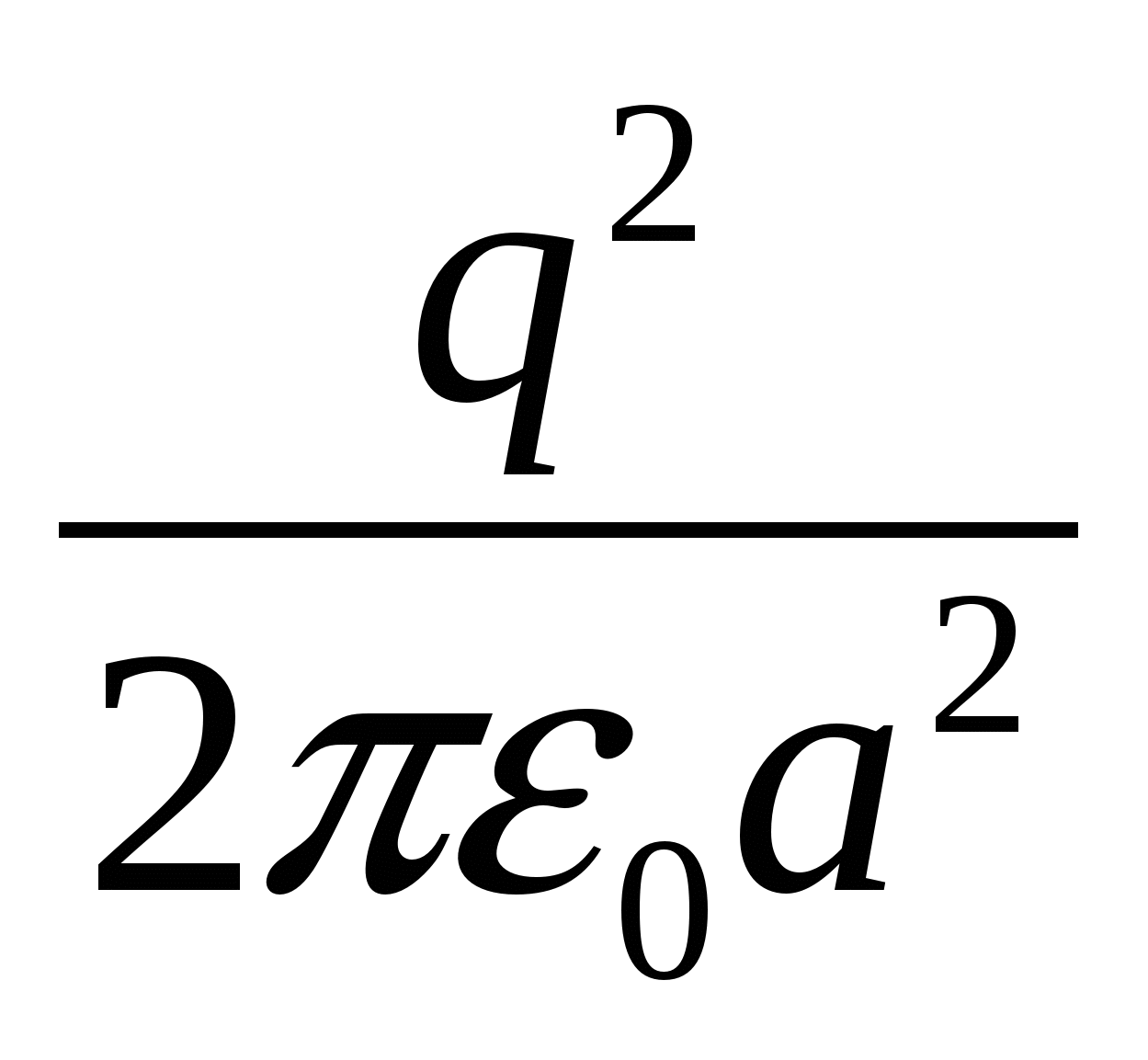 .
.
3.25. A small ball of mass m and charge q 1 is suspended on a silk thread in the air. If a certain charge q 2 is placed under the ball at a distance R from it, the thread tension force decreases by 2 times. Determine the amount of charge q 2 .
BUT.)  ; B.)
; B.)  ; AT.)
; AT.)  ; G.)
; G.)  .
.
3.26. A point charge 1 ∙ 10 -7 C is placed in a vacuum, and a point charge 3 ∙ 10 -7 C is placed in some liquid. The field strengths at points equidistant from the charges are the same. Determine permittivity liquids.
A.) 9; B.) 1/9; AT 3; G.) 1/3.
3.27. A ball with a mass of 1 g and a charge of 9.8 ∙ 10 -8 C is suspended in the air on a thin silk thread. The thread is 45 0 with the vertical if a second ball with a charge of the opposite sign is placed at a distance of 3 cm from the first ball. Determine its charge.
A.) 9 ∙ 10 -17 C; B.) 9 ∙ 10 -15 C; B.) 9 ∙ 10 -12 C; G.) 10 -8 Cl.
3 .28. The field was created by a charge of 10 -8 C. What work is done by the forces when moving a proton from a point located at a distance of 16 cm from the charge to a distance of 20 cm from it?
.28. The field was created by a charge of 10 -8 C. What work is done by the forces when moving a proton from a point located at a distance of 16 cm from the charge to a distance of 20 cm from it?
A.) 2 ∙ 10 -18 J; B.) 18 ∙ 10 -18 J; B.) 2 ∙ 10 -16 J; G.) 2 ∙ 10 -27 J.
3.29. The potential difference between the plates is 100 V. One of the plates is grounded (see Fig. 17). Determine the potential of points A, B, C, D, E, K.
| Answer | φ A | Φ B | Φ C | Φ D | Φ E | Φ K |
| BUT | 50 | 50 | 75 | 25 | 100 | 0 |
| B | 50 | 50 | 25 | 75 | 0 | 100 |
| AT | 100 | 100 | 100 | 100 | 0 | 0 |
3.30. A flat air capacitor with a capacity of 20 pF is charged to a potential difference of 100 V and is disconnected from the source. What work must be done to double the distance between the capacitor plates?
A.) 2 ∙ 10 -7 J; B.) 0.5 ∙ 10 -7 J; C.) 10 -7 J.
Keys of correct answers
| Job level | Task numbers and correct answers |
|||||||||
| 1 level (1 point) | 3.01 | 3.02 | 3.03 | 3.04 | 3.05 | 3.06 | 3.07 | 3.08 | 3.09 | 3.10 |
| B | AT | BUT | AT | B | BUT | BUT | B | BUT | AT |
|
| 2 level (2 points) | 3.11 | 3.12 | 3.13 | 3.14 | 3.15 | 3.16 | 3.17 | 3.18 | 3.19 | 3.20 |
| AT | AT | BUT | AT | AT | AT | B | G | B | G |
|
| 3 level (3 points) | 3.21 | 3.22 | 3.23 | 3.24 | 3.25 | 3.26 | 3.27 | 3.28 | 3.29 | 3.30 |
| BUT | B | AT | AT | BUT | AT | G | B | BUT | AT |
|
Action at a distance (long range)
The concept of the interaction of electric charges is considered in, which explains exactly how the charges interact. Charges of the same sign repel, and charges of opposite signs attract. Coulomb's law is valid for two point charges, when there are no other charges near or their value is negligible, that is, there are, as it were, only two acting point charges. If the charges are in motion, are not point charges, or these charges act in the electric field of other charges, then it is impossible to apply the Coulomb's Law formula.
The electric force of the interaction of charges is described as a non-contact action, in other words, there is a long-range action, that is, an action at a distance. In order to describe such a long-range action, it is convenient to introduce the concept of an electric field and use it to explain the action at a distance.
The concept of the electric field is expressed mathematical language in mathematical expressions and terms.
Electrical forces are non-contact
The concept of force is the concept (representation) of force in physics, as defined in Newton's three Laws. There are two categories of forces: contact forces and non-contact forces. Gravitational and electrical forces are non-contact and they are spoken of as far active forces Oh.
Gravitational forces are long-range forces, they act between two objects, even if they are at some distance from each other. A car freely rolling down a hill is an example of long-range forces when the Earth attracts another physical body- automobile. If you launch a projectile from an artillery gun, then it will move along a parabolic trajectory. During the flight of the projectile, it has no contact with the Earth and even with its surface, which indicates the absence of contact between them. Earth and a flying projectile non-contact action of gravitational forces. Electric charges interact similarly to such a long-range interaction. This interaction can be conveniently described using mathematical representation fields (electric, gravitational).
Electric field concept
Imagine a real field with an area of, for example, one hectare. Let it be sown with wheat. Let's say you wanted to explore where in the space of this field each grain of wheat is located and what mass it has. To do this, you will need to take a sheet of paper and draw the area of \u200b\u200bthis field on a scale, first plot the X and Y coordinate axes. Thus, you will get a coordinate grid like a table, where each cell has its own address in the form of X and Y values. Suppose that you managed to find each grain in this field and weigh it, and write the result in the cell corresponding to this place. As a result of a complete study of a real wheat field, you will receive on a sheet of paper its abstract mathematical representation in the form of the mass values of each grain. In the same way, you can examine temperature, humidity and other physical parameters in every place of the real field, and also enter the results into a sheet-table. This is the mathematical abstract representation of the field.
There are various physical quantities and characteristics that can be divided into two types. These are scalar, that is, quantities without direction, such as temperature, humidity, mass, density, etc., and vector physical quantities, which, unlike scalar ones, are characterized not only by size (number), but also by direction. Such a physical quantity as a force is a vector quantity, that is, it has not only a size (as well as scalars), but also a direction. How to take into account the direction? How to measure it? Temperature, humidity and pressure have a scale in the form of a line (one coordinate axis). This is a way to measure scalars. For vector quantities in the plane, two coordinate axes are required, and in space, three coordinate axes are required. To determine and measure the direction of vector quantities, the value of the angle of rotation of the vector relative to the origin is used. To write a vector, it is most convenient to use polar coordinates, but it is quite possible to get by with the usual Cartesian coordinates.
In the wheat field example above, when the grain mass was measured, a mathematical notation for a scalar quantity, the mass, was created. Such a notation can be called a scalar mathematical field. In order to describe in this way the electric forces acting in space at a long distance, that is, without contact, it is necessary to use a vector mathematical notation. This vector record will just represent what is called the electric field. A vector field differs from a scalar one in greater complexity and deeper understanding, since it is necessary to take into account the direction of action physical strength in addition to their magnitude (scalar).
It is important to remember that the record on a piece of paper, the representation of the field in the form is just a record, and in reality there are no such lines of force in space. Behind each record, the image of the field, is the original, that is, the real action of forces in space, either in potential or in actual action. We can say that the recording of the electric field in the form of numbers and lines, colors, etc. - this is just a photograph of the space under study, where the sources of acting forces are electric charges. Such a "photo" cannot be called a special kind of matter, but it can be argued that the entire space is filled with fields, the sources of which are long-range forces. The source of force is primary, and the mathematical notation of the vector or scalar field secondary. The source of power is real, and the record is just a "photograph", an image of the original.
Image of electric field
In order to record, to present in the form of information the action of the forces of electric charges, a mathematical vector field is used, which in space is depicted in the form of lines of force of two types. One kind of lines are equipotential, that is, formed equal values potential (tension), and another type of lines is called force. These lines of force intersect equipotential lines and are scales for the value of forces at points in space. To build a picture of the electric field, the calculation of the value of the electric field strength is used. The intensity value is basic in order to describe the interaction of charges through the representation of the electric field.






